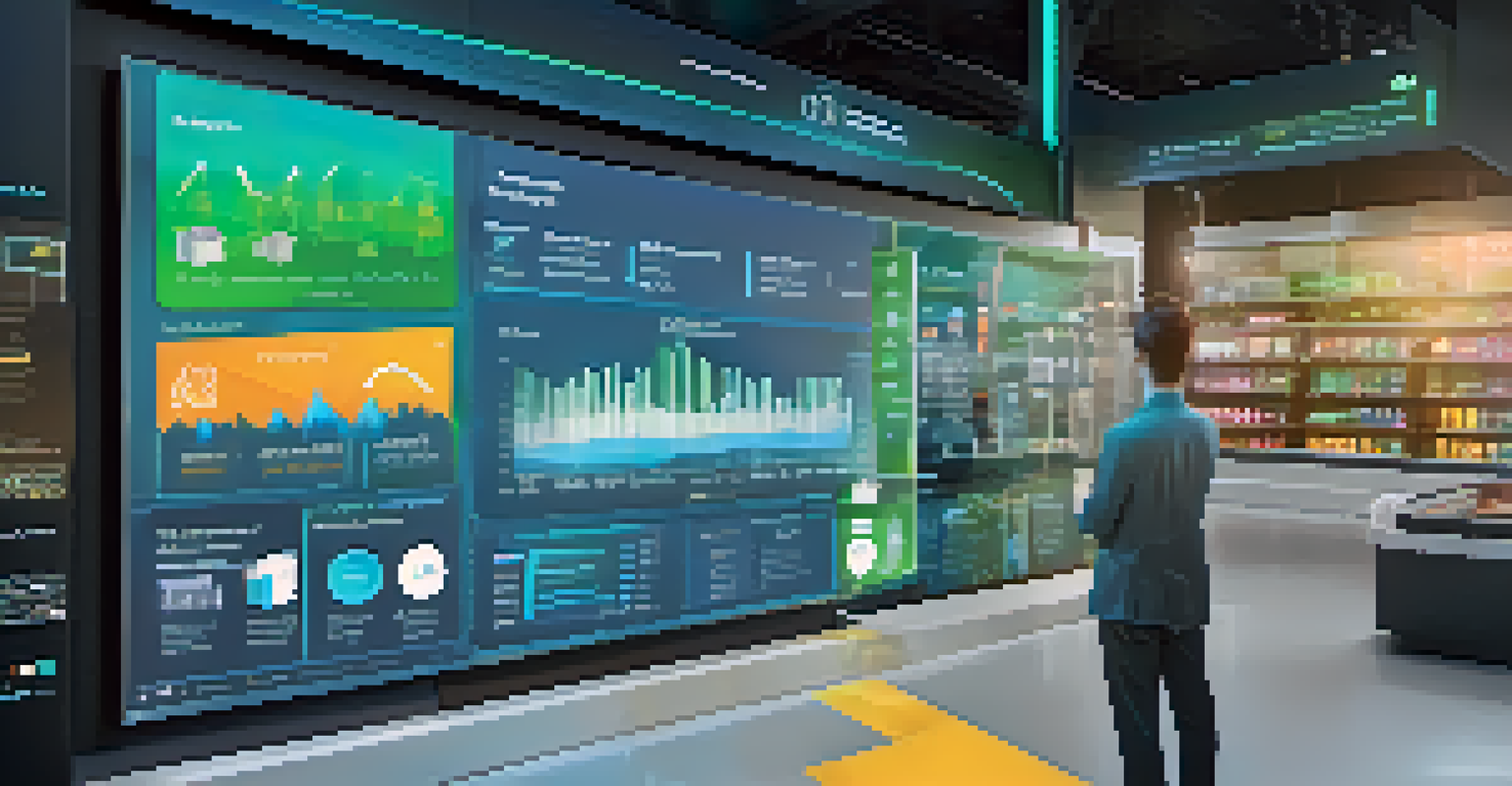Augmented Reality in Retail Analytics: Improving Insights

Understanding Augmented Reality in Retail
Augmented Reality (AR) is a technology that superimposes digital information onto the real world, enhancing our perception of reality. In retail, this means customers can visualize products in their own environment before making a purchase. Imagine trying on clothes virtually or seeing how a piece of furniture fits in your living room. This not only enriches the shopping experience but also provides valuable data to retailers about customer preferences.
The future of retail is in the experience, not just the transaction.
As AR technology evolves, its application in retail analytics is increasingly significant. Retailers can track how customers interact with AR features, providing insights into what products attract attention. This data helps businesses understand consumer behavior better and tailor their offerings accordingly.
Furthermore, AR can bridge the gap between online and in-store shopping. Customers who engage with AR experiences are often more likely to make a purchase, as they feel more confident in their choices. By integrating AR into their strategies, retailers can leverage analytics to boost sales and improve customer satisfaction.
Enhancing Customer Experience Through AR
One of the most exciting aspects of AR in retail is its ability to enhance the customer experience. By allowing shoppers to visualize products in a realistic context, AR creates an interactive and engaging shopping journey. For example, beauty brands often use AR apps that let customers try on makeup virtually, fostering a more personalized experience.

When customers enjoy their shopping experience, they're more likely to return. AR not only keeps shoppers engaged but also reduces the uncertainty that often accompanies online shopping. The ability to see how a product looks or fits in real life can significantly impact purchasing decisions.
AR Enhances Retail Shopping Experience
Augmented Reality allows customers to visualize products in their own environment, making shopping more interactive and personalized.
Moreover, this technology can lead to higher conversion rates for retailers. A seamless AR experience encourages customers to explore more products, increasing the likelihood of impulse buys. In a competitive market, enhancing customer experience through AR can be a game-changer for retailers looking to stand out.
Data Collection and Insights from AR Interactions
AR provides retailers with a wealth of data on customer interactions. Each time a customer engages with an AR feature, valuable insights can be collected. This includes information on which products were viewed, how long they were interacted with, and what features were most popular.
Augmented reality is going to be a big part of our lives, and it's going to change the way we shop.
Analyzing this data helps retailers identify trends and patterns in consumer behavior. For instance, if a specific item consistently garners attention through AR, it might indicate a growing trend. Retailers can then adjust their inventory and marketing strategies to align with these insights.
Furthermore, the feedback loop created by AR interactions allows for continuous improvement. Retailers can refine their AR experiences based on customer preferences, ensuring that they remain relevant and appealing. This adaptability is crucial in today's fast-paced retail environment.
Integrating AR with Existing Retail Analytics
For retailers to fully leverage AR, it must be seamlessly integrated with existing analytics systems. This integration allows for a more comprehensive view of customer behavior, combining traditional sales data with AR interaction metrics. By doing so, retailers can paint a clearer picture of the customer journey.
Using advanced analytics tools, retailers can analyze how AR impacts different stages of the shopping process. For example, they can track if customers who engage with AR features tend to make larger purchases or have lower return rates. These insights can help shape marketing strategies and inventory management.
Data Insights Transform Retail Strategies
AR interactions provide retailers with valuable data on customer preferences, helping them tailor their offerings and optimize inventory.
Moreover, this integration can lead to more informed decision-making. Retailers can allocate resources more effectively, focusing on AR features that drive sales and enhance customer satisfaction. In a world where data-driven decisions are key, combining AR with analytics is essential for success.
AR's Impact on Inventory Management
AR technology can also play a significant role in inventory management. By providing insights into which products capture customer interest, retailers can optimize their stock levels. This reduces the risk of overstocking items that don’t sell and ensures popular products are readily available.
Additionally, AR can help retailers understand seasonality and trends more effectively. By analyzing AR engagement data over time, businesses can anticipate shifts in consumer preferences, allowing them to adjust their inventory proactively. This not only improves efficiency but also enhances customer satisfaction.
Having the right products at the right time is crucial for retail success. AR offers a modern solution to an age-old problem, helping retailers maintain a competitive edge. By leveraging these insights, businesses can meet customer demands and minimize waste.
Challenges in Implementing AR in Retail Analytics
While the benefits of AR in retail analytics are compelling, there are challenges to consider. One significant hurdle is the initial investment in AR technology and infrastructure. Retailers must weigh the costs against potential returns to determine if AR is a viable option for their business.
Moreover, there is a learning curve associated with adopting new technologies. Staff training and customer education are essential for maximizing the benefits of AR. Retailers need to ensure that both employees and customers are comfortable using this technology to truly harness its potential.
Challenges in AR Implementation
While AR offers significant benefits, retailers face challenges like initial costs, staff training, and data privacy concerns.
Lastly, data privacy concerns cannot be overlooked. As retailers collect more data through AR interactions, they must prioritize customer privacy and comply with data protection regulations. Establishing trust with customers is vital for the long-term success of any AR initiative.
The Future of AR in Retail Analytics
As technology continues to advance, the future of AR in retail analytics looks promising. We can expect to see more sophisticated AR applications that offer even deeper insights into consumer behavior. Innovations such as AI-driven analytics could enhance the capabilities of AR, providing retailers with unprecedented data.
Additionally, as consumer acceptance of AR grows, more retailers are likely to adopt this technology to stay competitive. The integration of AR with e-commerce and physical retail spaces will create a truly omnichannel experience for customers, bridging the gap between online and offline shopping.

Ultimately, the evolution of AR in retail analytics will depend on how well retailers adapt to changing consumer preferences. By staying ahead of the curve and continuously refining their strategies, businesses can thrive in an increasingly digital marketplace. The potential for growth is immense, and those who embrace AR today could lead the retail landscape of tomorrow.